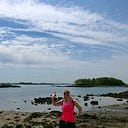What is GIS and How Can it Help Battle Climate Change?
I have a pile of roughly seven, unread New Yorkers on my coffee table. I admit that I will never catch up to the current issue… I dream of leisurely reading every article throughout the week only to have a new one arrive just as I put last weeks in the recycling bin. Despite being a couple months behind, I am always enthusiastic about the variety of topics the New Yorker offers. In an article from early February, I read about a Catholic climate activist named Molly Burhans, who founded a site called GoodLands that maps the Catholic Churches land assets using GIS technology. Their main goal is to mobilize the Church to use their land for good — focusing on ending homelessness, preventing environmental destruction, and promoting sustainability in general. Molly and her organization made a huge impression on me — the integration of her passions (Catholicism and ecology) with technology sparked my interest in diving a bit further into the realm of GIS.
So, What is GIS?
GIS stands for Geographic Information Systems. Rooted in the science of geography, it’s a framework that helps gather, manage and store data. So for example, a GIS can store data referring to vegetation, street routes, levels of pollution that you can then “layer” on top of one another to get a geographic visualization (using mainly maps or 3D objects) — providing a much easier way to analyze and understand the data. If you have ever used Google Maps, you are using a GIS — here your location is set by using GPS (Global Positioning System) that is then processed and layered on top of a map by a GIS to give you an idea of where you are located.
The power of GIS technology is not just within its ability to visualize this data, but also in the analysis. It can reveal patterns or relationships that maybe have yet to be apparent between two different sets of data. In the New Yorker article, the author David Owen, mentions an English physician named John Snow who created a forerunner to this GIS technology and which I think exemplifies how powerful these tools can be.
Disease Mapping
In 1854, there was an outbreak of cholera in the SoHo neighborhood of London. During that time, Cholera, among other diseases, were believed to spread via “miasma” in the air. Miasma was the term for ‘night air’ or air containing noxious gases that spread disease. John Snow approached the outbreak in a unique manner for the time — he drew a small black box for each case of Cholera on a map of Broad street, the area most effected by the disease. What it ended up revealing was that the cases were clustered around a water pump in the center of the neighborhood. There was also a brewery near which showed far fewer cases — turns out the workers had their own water supply (and drank beer, naturally). It was not only through the visualization, but also through the analysis of various layers of data (Cholera cases and the local water pumps) that Snow could discover the water supply that had been contaminated. Snow’s map had a huge impact on the understanding of infectious disease and also saved many lives — residents were instructed to boil their water, and so ended the last Cholera outbreak London has seen.
GIS and Sustainability
Molly Burhans and GoodLands are not the only ones using GIS to promote a healthy relationship to the world around us. Data about environmental resources, deforestation, fragile ecosystems, etc. is constantly being collected and updated — the impacts on our environment change almost daily. GIS allows us to visualize and analyze these massive sets of information. It can monitor changes and predict environmental outcomes. It provides the information and analytical capabilities required for making decisions that increase economic efficiencies and minimize consumption and contamination.
Take a look at SeaSketch — an application that is part of the Esri Ocean GIS Initiative that is designed to foster a healthy relationship to our oceans. Damon Stanwell-Smith of United Nations Environment Programme Conservation Monitoring Centre discusses the impact of technology such as SeaSketch:
“We will use it to get people talking about sustainable ocean management and to consider ocean biodiversity in their ocean use projects. Working on the platform, we can have a discussion in the same room or on another continent.”
In the example above, conservationists can show the nominal costs of rerouting ships away from whale migration areas. This could have an instrumental impact on saving our whales and marine life in general. Although GIS isn’t inherently “good” or “bad,” I feel optimistic that this type of technology can aid the organizations working to heal our planet and reduce our already overbearing footprint.
I hope to continue to learn about GIS and dabble in some software in the near future — look out for the next blog!
